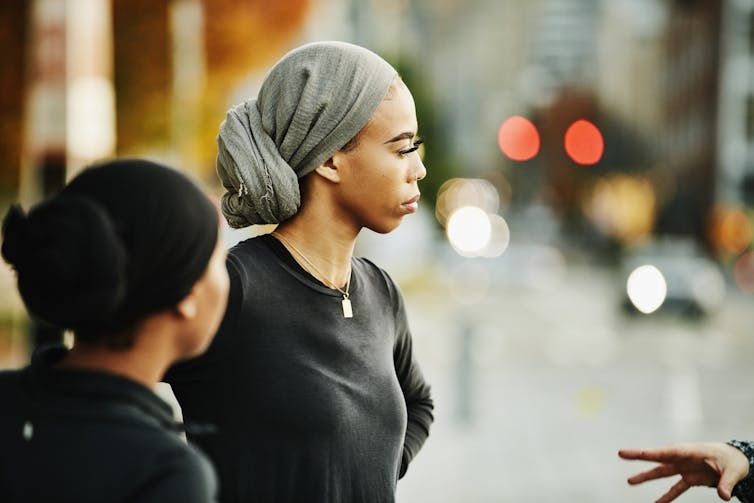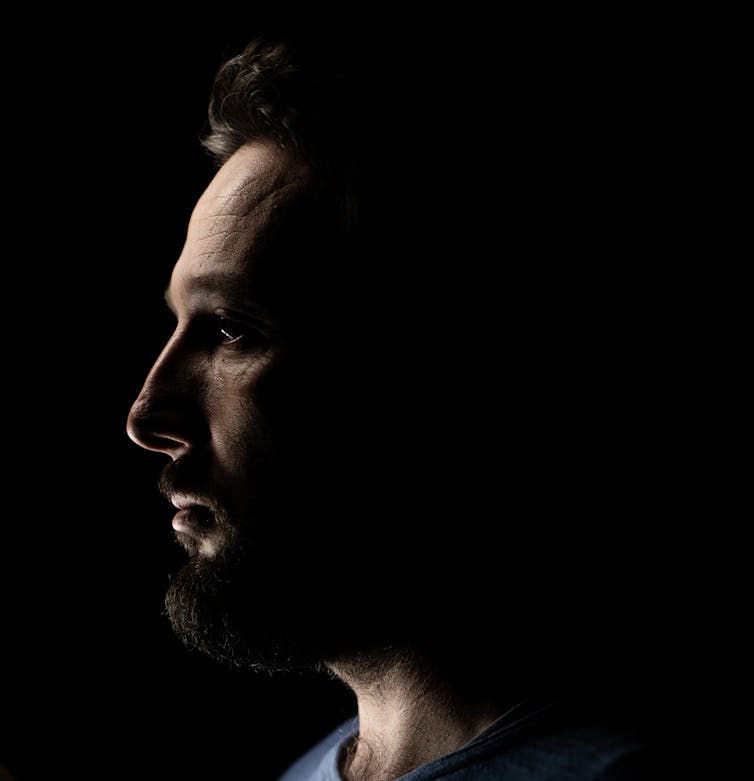American Muslims are at high risk of suicide -- 20 years post-9/11, the links between Islamophobia and suicide remain unexplored
- Written by Amelia Noor-Oshiro, PhD Candidate in Public Health, Johns Hopkins University
This year, 9/11 holds a dual significance for Americans across the country. It not only marks the 20th anniversary of the tragic events and lives lost since Sept. 11, 2001, but also National Suicide Prevention Awareness Week[1]. For American Muslims who are both victims of increased rates of Islamophobic violence[2] and survivors of suicide attempts, this juxtaposition is especially stark.
In the field of public health[3], Islamophobia is recognized as akin to racism in how it leads to negative physical and psychological health outcomes[4]. But this definition misses the crucial elements of structural violence[5] and social stigma that underlie the hate crimes and microaggressions[6] American Muslims face. These elements are not only the key ingredients in such acts of social violence, but also the same risk factors for individual self-directed violence, which is the definition of suicide[7].
I am the first self-identifying Muslim American to receive federal funding[8] from the National Institutes of Health to conduct grassroots mental health research within the American Muslim community. I identify as a victim of Islamophobic violence and a survivor of a suicide attempt[9]. The hypothesis of my research is that the past two decades of anti-Muslim stigma in the sociopolitical climate of post-9/11 America have created the necessary conditions[10] for young Muslims in America to internalize self-hatred and ultimately attempt suicide.
 American Muslims constitute a diverse group of racial minorities and immigrants with unique life experiences.
Thomas Barwick/DigitalVision via Getty Images[11]
American Muslims constitute a diverse group of racial minorities and immigrants with unique life experiences.
Thomas Barwick/DigitalVision via Getty Images[11]
Suicide disparities and risk factors in American Muslims
Suicide is a major public health concern[12] worldwide. It is a top 10 leading cause of death in this country and the No. 1 leading cause of death in certain populations[13]. A July 2021 study revealed that American Muslims report two times the odds of a suicide attempt[14] in their life compared to other faith groups. These findings suggest a disparity and indicate that there is a unique set of factors that increases American Muslims’ risk of suicide.
In general, there are many elements that contribute to suicide risk[15]. Some of these include a past history of mental illness, knowing someone who previously attempted suicide and having access to lethal means like guns. Research studies on suicide risk in American Muslims, however, must specifically account for our distinct experience of being racialized[16], stigmatized and “othered”[17] in post-9/11 America. Given the unique experience of Islamophobia[18] that Muslims in America face, a scientific focus on these social factors is essential for studies on American Muslims.
A 2019 Pew Research Center survey[19] measuring the level of warmth or coldness that U.S. adults felt toward certain religious groups found that Muslims were placed toward the extremes of the cold end of the scale. A 2017 survey from Pew found that half of U.S. adults[20] said Islam is not a part of mainstream society and perceived at least some Muslims as anti-American.
These attitudes point to how being a Muslim has been stigmatized in America. There is abundant evidence that stigma is a fundamental cause of health disparities[21], especially as it relates to suicide among people with minority identities[22]. I argue that the stigma of being Muslim in America results in exposure to Islamophobic violence that can lead to increased suicide risk and disparity.
The intersectionality of Muslim American identity
But being Muslim is not the only form of stigma and structural violence that American Muslims face. American Muslims are a very heterogenous group[23] with diverse[24] backgrounds as racial minorities[25] and forced and voluntary migrants[26]. Coming from over 77 countries, nearly 80%[27] of us are first- or second-generation immigrants, and the majority are racial and ethnic minorities. It is the combined identities of being a Muslim, a racial or ethnic minority and of immigrant-origin that results in intersectional stigma[28]– these identities converge and interact with each other in ways that can negatively affect health.
Therefore, a more scientifically accurate understanding of Islamophobia endorses the intersectionality of our stigma as a key variable contributing to suicide risk. Research on American Muslims addresses the dearth of scientific knowledge on culturally specific social factors of suicide. Yet for American Muslims, what factors contribute to our risk for suicide and what protective factors build our resilience are still to be uncovered.
Challenges in American Muslim mental health research
Prior to 2006, the PubMed[29] research database returned fewer than 70 search results on “Muslim” and “mental health.” Major grants for funding research on this topic were nonexistent. The launch of the Journal of Muslim Mental Health[30] that year attempted to fill this crucial research gap. Today, the over 700 search results with the terms “Muslim” and “mental health” still represent less than one-thousandth of a percent of over 320,000 results on mental health overall[31]. Evidently, the study of suicide in American Muslims itself faces disparities.
A major barrier to expanding research on American Muslim mental health is access to federal funding. The National Institute on Minority Health and Health Disparities[32] designates certain groups as disparity populations, which does not include faith groups. While Muslims constitute only 1%[33] of the U.S. population, we are projected to become the world’s largest faith group[34] by the second half of this century. Even so, data on American Muslim health is missing[35] due to a lack of research resources and scientific interest.
 Because of how American Muslims are demographically defined in research, health data about this community is lacking.
Jasmin Merdan/Moment via Getty Images[36]
Because of how American Muslims are demographically defined in research, health data about this community is lacking.
Jasmin Merdan/Moment via Getty Images[36]
Research on American Muslims relies on select elements of our identities as racial minorities and immigrants to qualify for research funding. But these qualities alone do not fully capture American Muslim lived experiences with Islamophobia and faith-based stigma, prejudice and discrimination. Without data and research on our community, American Muslims may not be considered a disparity group under current classifications and therefore miss critical funding opportunities.
Suicide research on American Muslims may advance insights across diverse communities
What will America look like by the time we mark the 50th anniversary of 9/11?
By 2051, the diversification of the American population[37] will reveal a majority minority[38] racial and ethnic demographic. Already, the majority of youth under 18 are people of color. Forty years from now, first- and second-generation immigrants will encompass over a third of the population[39].
Alarmingly, second-generation immigrants[40] worldwide are considered an at-risk group for suicide. The diverse new generations in America are born into adverse conditions that expose them to race-based trauma[41] and minority stress[42], or the cumulative negative health effects caused by racism and by being a part of a stigmatized minority group, respectively.
The intersectional discrimination that American Muslims already experience today makes a strong case that we are a crucial reference group when it comes to future mental health research on diverse and marginalized communities. The immense value of culturally relevant research on suicide among American Muslims is evident from its substantial potential to apply across different racial, ethnic and immigrant groups.
Insights from the American Muslim lived experience may provide science with the tools to make sure suicide in minority communities becomes a thing of the past.
If you are struggling with suicidal thoughts, please call the suicide helpline now at 1-800-273-8255 (TALK) or visit the National Suicide Prevention Lifeline[43] website. You are not alone and there is hope.
[Get the best of The Conversation, every weekend. Sign up for our weekly newsletter[44].]
References
- ^ National Suicide Prevention Awareness Week (afsp.org)
- ^ increased rates of Islamophobic violence (news.gallup.com)
- ^ public health (dx.doi.org)
- ^ negative physical and psychological health outcomes (dx.doi.org)
- ^ structural violence (doi.org)
- ^ hate crimes and microaggressions (www.cair.com)
- ^ self-directed violence, which is the definition of suicide (www.mirecc.va.gov)
- ^ receive federal funding (reporter.nih.gov)
- ^ survivor of a suicide attempt (www.amelianooroshiro.com)
- ^ necessary conditions (doi.org)
- ^ Thomas Barwick/DigitalVision via Getty Images (www.gettyimages.com)
- ^ major public health concern (www.nimh.nih.gov)
- ^ certain populations (theconversation.com)
- ^ two times the odds of a suicide attempt (doi.org)
- ^ suicide risk (www.cdc.gov)
- ^ racialized (libguides.uwinnipeg.ca)
- ^ “othered” (www.theguardian.com)
- ^ experience of Islamophobia (www.ispu.org)
- ^ 2019 Pew Research Center survey (www.pewforum.org)
- ^ half of U.S. adults (www.pewforum.org)
- ^ stigma is a fundamental cause of health disparities (doi.org)
- ^ suicide among people with minority identities (www.apa.org)
- ^ very heterogenous group (www.pewresearch.org)
- ^ diverse (theconversation.com)
- ^ racial minorities (www.pewresearch.org)
- ^ forced and voluntary migrants (www.thoughtco.com)
- ^ nearly 80% (www.pewresearch.org)
- ^ intersectional stigma (doi.org)
- ^ PubMed (pubmed.ncbi.nlm.nih.gov)
- ^ Journal of Muslim Mental Health (www.doi.org)
- ^ mental health overall (pubmed.ncbi.nlm.nih.gov)
- ^ National Institute on Minority Health and Health Disparities (www.nimhd.nih.gov)
- ^ constitute only 1% (www.pewresearch.org)
- ^ world’s largest faith group (www.pewresearch.org)
- ^ data on American Muslim health is missing (doi.org)
- ^ Jasmin Merdan/Moment via Getty Images (www.gettyimages.com)
- ^ diversification of the American population (www.washingtonpost.com)
- ^ majority minority (www.nytimes.com)
- ^ over a third of the population (www.pewresearch.org)
- ^ second-generation immigrants (dx.doi.org)
- ^ race-based trauma (www.ptsd.va.gov)
- ^ minority stress (www.apa.org)
- ^ National Suicide Prevention Lifeline (suicidepreventionlifeline.org)
- ^ Sign up for our weekly newsletter (theconversation.com)














